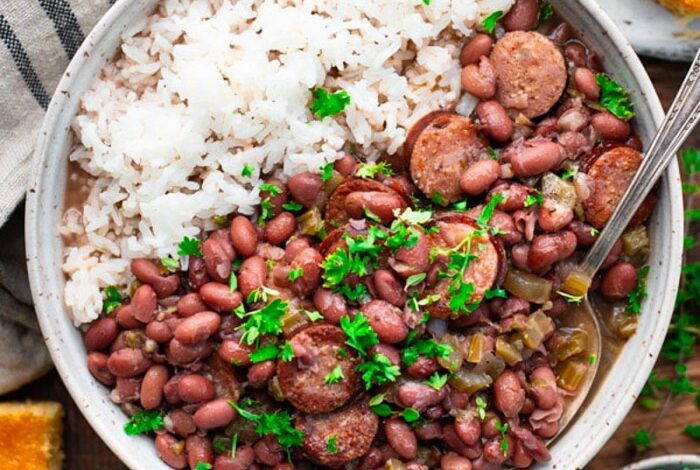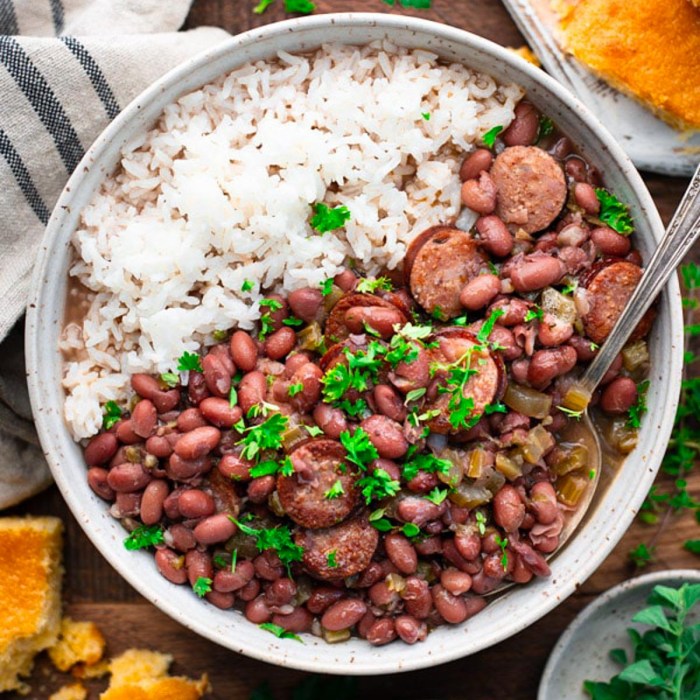
Authentic No Shortcuts Louisiana Red Beans and Rice: A Culinary Journey
Authentic No Shortcuts Louisiana Red Beans and Rice: A Culinary Journey, isn’t just a dish, it’s a cultural experience. It’s a story of history, tradition, and flavor that has been passed down through generations. From the humble beginnings of a simple meal for slaves to the beloved staple of Louisiana cuisine, red beans and rice has evolved into a symbol of community and heritage.
This dish isn’t just about throwing ingredients together; it’s about embracing the techniques and traditions that make it truly authentic. From the slow simmering of beans to the art of seasoning with the perfect blend of spices, every step is crucial to creating a flavor that is both comforting and complex.
This is more than just a recipe; it’s a journey through the heart and soul of Louisiana.
The History and Origins of Red Beans and Rice
Red beans and rice, a staple of Louisiana cuisine, is a dish steeped in history and cultural significance. Its roots trace back to the African diaspora and the influence of French and Spanish colonization, creating a culinary masterpiece that embodies the state’s rich heritage.
The Influence of African American Traditions
Red beans and rice’s connection to African American traditions is deeply ingrained in its history. The dish originated in the kitchens of enslaved Africans who used readily available ingredients, including red beans, rice, and seasonings, to create nourishing meals. Red beans, a hearty and inexpensive legume, were a key ingredient in West African cuisine, while rice was introduced through the transatlantic slave trade.
The combination of these ingredients, along with the addition of spices and herbs, formed the foundation of red beans and rice as we know it today.
The Evolution of the Dish
Over time, red beans and rice evolved as a reflection of the cultural fusion that characterized Louisiana. French and Spanish influences brought new flavors and techniques, incorporating ingredients like ham hocks, smoked sausage, and spices like cayenne pepper. The dish also adapted to local availability and resources, with variations emerging in different regions of the state.
There’s something about the slow simmering of authentic Louisiana red beans and rice that just makes you feel good. It’s a dish that requires time and attention, and the result is a hearty, flavorful meal that’s perfect for a chilly evening.
But sometimes, you crave something lighter and brighter, like a refreshing cold asparagus with prosciutto and lemon. The crispness of the asparagus, the salty prosciutto, and the tangy lemon create a beautiful contrast of textures and flavors. And when you’re done, you’ll be ready to dive back into that pot of red beans and rice with renewed appreciation.
Regional Variations and Influences
Red beans and rice has a distinct character depending on the region of Louisiana where it is prepared. In New Orleans, the dish is often served with a spicy and savory sauce, reflecting the city’s Creole heritage. In rural areas, the focus is on simplicity and using fresh, local ingredients.
The Authentic Louisiana Red Beans and Rice Experience: Authentic No Shortcuts Louisiana Red Beans And Rice

The heart and soul of Louisiana red beans and rice lie in the simplicity and authenticity of its preparation. The dish is a testament to the resourcefulness and culinary traditions of the region, using readily available ingredients and time-honored techniques to create a flavor that is both comforting and satisfying.
Essential Ingredients and Their Role in Creating Authentic Flavor, Authentic no shortcuts louisiana red beans and rice
The key to authentic Louisiana red beans and rice lies in the quality and combination of its ingredients. Each element plays a vital role in creating the signature taste and texture of this beloved dish.
- Red Beans:The foundation of the dish, red beans provide a creamy texture and earthy flavor. Traditionally, “small red beans” are preferred for their rich taste and ability to hold their shape during cooking.
- Smoked Meats:The backbone of the flavor profile, smoked meats like ham hocks, andouille sausage, or bacon add a smoky depth and savory richness. These meats are typically cooked with the beans, infusing them with their distinctive aroma and flavor.
- The Holy Trinity:This essential combination of celery, onion, and green bell pepper forms the base of the flavor profile. The trinity is sautéed in oil or rendered fat, creating a fragrant foundation that complements the other ingredients.
- Stock or Water:The liquid used to cook the beans plays a significant role in the final result. Traditionally, water is used, but chicken or vegetable stock can enhance the flavor and richness.
- Seasonings:A blend of spices, typically including cayenne pepper, black pepper, thyme, and bay leaves, adds complexity and depth to the dish. The amount of cayenne pepper can be adjusted to taste, creating a range of spiciness from mild to fiery.
- Rice:White long-grain rice is the traditional accompaniment to red beans and rice. It provides a neutral canvas for the rich flavors of the beans and meat, creating a satisfying balance of textures.
Traditional Cooking Methods and Techniques
The slow simmering method is central to creating the perfect Louisiana red beans and rice. This time-honored technique allows the beans to soften and absorb the flavors of the other ingredients, resulting in a rich and flavorful dish.
- Sautéing the Holy Trinity:The process begins by sautéing the chopped celery, onion, and green bell pepper in oil or rendered fat until softened. This creates a flavorful base for the beans and meats.
- Adding the Beans and Meats:The red beans and smoked meats are then added to the pot along with the seasoning and stock or water. The mixture is brought to a boil, then reduced to a simmer and cooked for several hours until the beans are tender and the flavors have melded together.
- Slow Simmering:The key to success lies in slow simmering, allowing the beans to break down and release their starches, creating a creamy texture. The slow cooking process also allows the flavors of the ingredients to meld together, resulting in a complex and satisfying taste.
- Adjusting Seasoning:As the beans simmer, taste the mixture and adjust the seasoning as needed. This is an essential step in achieving the perfect balance of flavors.
- Serving:Once the beans are cooked, the rice is prepared separately and served alongside the red beans. The dish is traditionally topped with chopped green onions or parsley for a final touch of freshness.
Key Characteristics That Define Authentic Louisiana Red Beans and Rice
- Flavor:Authentic Louisiana red beans and rice is characterized by a rich, savory, and slightly spicy flavor profile. The smoked meats contribute a smoky depth, while the holy trinity provides a subtle sweetness and the seasonings add a touch of heat.
- Texture:The beans should be tender and creamy, with a slight bite. The rice should be fluffy and slightly sticky, providing a pleasing contrast to the beans.
- Color:The red beans should have a deep red color, indicating that they have been cooked properly and have released their starches. The rice should be a pearly white, complementing the vibrant color of the beans.
- Aroma:The dish should have a distinctive aroma, a blend of smoky, savory, and slightly spicy notes. The aroma should be inviting and tantalizing, signaling the deliciousness that awaits.
The Importance of Using Fresh, High-Quality Ingredients

Red beans and rice, a Louisiana culinary staple, is a dish that thrives on the quality of its ingredients. While simplicity is at its core, using fresh, high-quality ingredients elevates this dish to new heights of flavor and texture. The richness of the beans, the heartiness of the rice, and the depth of the seasonings all contribute to a truly authentic and satisfying experience.
Authentic Louisiana red beans and rice is all about slow cooking, letting the flavors meld and deepen over time. It’s a dish that evokes memories of lazy Sunday afternoons and family gatherings. While I’m savoring those hearty beans, I can’t help but think of Oma’s fabulous matzo ball soup, a comforting classic that brings back childhood memories.
Both dishes are simple yet incredibly satisfying, a testament to the power of traditional cooking. And just like Oma’s soup, those beans are best enjoyed with a generous dollop of hot sauce, a touch of spice to round out the flavors.
The Benefits of Sourcing Local Ingredients
Sourcing local ingredients for your red beans and rice offers a multitude of benefits. Firstly, it supports local farmers and businesses, contributing to the economic vitality of your community. Secondly, locally sourced ingredients are often fresher and more flavorful, as they haven’t traveled long distances and haven’t been subjected to extended storage.
Lastly, using local ingredients reduces your carbon footprint, promoting sustainability and environmental responsibility.
Examples of High-Quality Ingredients and Their Impact on Flavor
The quality of ingredients significantly impacts the final flavor profile of red beans and rice.
Beans
- Red Beans:Choose red beans that are plump, firm, and free from blemishes. Avoid beans that are shriveled or discolored, as they may be old or damaged.
- Other Beans:While red beans are the traditional choice, you can experiment with other beans like black beans, pinto beans, or kidney beans for a twist on the classic recipe.
Rice
- Long-Grain Rice:Long-grain rice, such as Louisiana white rice, is the preferred choice for red beans and rice. Its fluffy texture and ability to absorb the flavorful broth perfectly complement the beans.
- Other Rice Varieties:While long-grain rice is traditional, you can experiment with other rice varieties like brown rice or wild rice for a more complex flavor and texture.
Seasonings
- Sliced Smoked Sausage:The smoky flavor of sliced smoked sausage adds a depth of flavor that is essential for authentic red beans and rice. Look for sausage made with high-quality pork and natural seasonings.
- Andouille Sausage:Another popular choice for red beans and rice is andouille sausage, a spicy Cajun sausage that adds a kick of heat.
- Bell Peppers and Onions:The sweetness of bell peppers and the savory flavor of onions add a bright and vibrant element to the dish. Choose fresh, crisp vegetables for the best flavor.
- Garlic and Celery:The pungent flavor of garlic and the subtle earthiness of celery contribute to the complex aroma and flavor of the dish.
- Bay Leaf:A bay leaf adds a subtle, earthy note to the dish, enhancing the overall flavor profile.
- Cayenne Pepper:Cayenne pepper adds a touch of heat to the dish, but it should be used sparingly to avoid overpowering the other flavors.
- Salt and Black Pepper:These basic seasonings are essential for balancing the flavors of the dish.
The Importance of Selecting the Right Type of Red Beans for Optimal Results
Selecting the right type of red beans is crucial for achieving the desired texture and flavor in your red beans and rice. The most common type of red bean used in Louisiana is the “small red”bean. These beans have a smooth, creamy texture and a mild flavor that absorbs the flavors of the other ingredients perfectly.
“The key to good red beans and rice is to use fresh, high-quality ingredients. The difference in flavor is noticeable.”
Louisiana Chef
The Art of Seasoning and Flavor Enhancement
The magic of Louisiana red beans and rice lies not only in its humble ingredients but also in the art of seasoning. It’s the skillful blend of spices, herbs, and aromatics that transforms this simple dish into a culinary masterpiece.
Seasoning is more than just adding flavor; it’s about creating depth, complexity, and a harmonious balance that tantalizes the taste buds.
The Role of Spices, Herbs, and Aromatics
Spices, herbs, and aromatics play a crucial role in elevating the flavor profile of red beans and rice. They add warmth, depth, and a touch of magic to the dish.
- Spices:Spices, such as cayenne pepper, paprika, and black pepper, provide heat, smokiness, and a hint of earthiness. They create a foundation for the flavor profile.
- Herbs:Fresh or dried herbs, such as thyme, bay leaves, and parsley, contribute a herbaceous aroma and a touch of freshness. They add complexity and balance to the dish.
- Aromatics:Aromatics like onions, celery, and bell peppers, when sautéed, release their fragrant oils, adding a base of sweetness and savory notes to the dish. They create a foundation for the flavor profile.
Traditional Seasoning Combinations
Traditional Louisiana red beans and rice recipes often feature specific seasoning combinations that have been passed down through generations. These combinations are not just about taste; they represent the rich culinary heritage of the region.
- The Holy Trinity:This classic combination of onions, celery, and green bell peppers is the foundation of many Cajun and Creole dishes. It creates a base of sweetness and savory notes that complement the red beans.
- The Cajun Spice Blend:This blend typically includes cayenne pepper, paprika, garlic powder, onion powder, and black pepper. It provides heat, smokiness, and a hint of earthiness, giving the dish its characteristic Cajun flavor.
- The Creole Spice Blend:This blend often includes a combination of herbs and spices, such as thyme, bay leaves, parsley, and black pepper. It adds a touch of freshness and complexity to the dish, giving it a more nuanced flavor profile.
Tips and Tricks for Seasoning Red Beans and Rice to Perfection
Seasoning red beans and rice is a matter of personal preference and experimentation. Here are some tips and tricks to help you achieve the perfect flavor:
- Start with a base of aromatics:Sautéing onions, celery, and green bell peppers in a little oil creates a flavorful base for the dish.
- Use fresh herbs whenever possible:Fresh herbs add a brighter, more vibrant flavor to the dish.
- Don’t be afraid to experiment with different spices:Try adding a pinch of smoked paprika, a bay leaf, or a sprinkle of chili powder to create unique flavor profiles.
- Season in stages:Add spices and herbs throughout the cooking process to allow the flavors to develop.
- Taste and adjust:Always taste the dish as it cooks and adjust the seasoning accordingly.
The Cultural Significance of Red Beans and Rice
In Louisiana, red beans and rice are more than just a delicious meal; they are a cultural cornerstone, deeply woven into the state’s social fabric and everyday life. This humble dish has played a vital role in shaping the culinary landscape and traditions of Louisiana, reflecting the state’s rich history and diverse cultural influences.
Red Beans and Rice: A Weekly Ritual
Red beans and rice in Louisiana have become a beloved tradition, enjoyed every Monday. This tradition is deeply rooted in the state’s history, particularly the era of slavery. Monday was traditionally a day of rest for enslaved people, and red beans and rice, a hearty and affordable dish, became a staple meal for families.
This practice has continued through generations, making Monday a day synonymous with red beans and rice in Louisiana.
There’s something about a slow-cooked pot of authentic Louisiana red beans and rice that just can’t be rushed. It’s about the time spent simmering, the earthy aroma filling the air, and the comforting flavors that develop with each passing hour.
While I’m all for a hearty meal, sometimes I crave something lighter and quicker. That’s when I turn to these crustless cottage cheese mini quiches – they’re packed with flavor, but ready in a flash. And just like those red beans, they’re perfect for a cozy night in, reminding me that sometimes the best things in life are the ones that take time to create.
Red Beans and Rice: A Symbol of Community
Red beans and rice have always been a dish that brings people together. In the past, families would often gather on Mondays to share a pot of red beans and rice, strengthening community bonds and fostering a sense of togetherness.
This tradition continues today, with many families still preparing large pots of red beans and rice to share with friends and neighbors. The dish has become a symbol of community, representing the spirit of generosity and shared meals that are so important in Louisiana culture.
Red Beans and Rice: A Celebration of Louisiana Cuisine
Red beans and rice are a cornerstone of Louisiana cuisine, celebrated in numerous ways. Many restaurants in Louisiana feature red beans and rice on their menus, showcasing the dish’s versatility and enduring popularity. The dish is also often served at festivals and special events, reflecting its importance in Louisiana’s culinary traditions.
Red Beans and Rice
Red beans and rice, a culinary icon of Louisiana, is more than just a dish; it’s a journey through the state’s rich history, vibrant culture, and diverse flavors. Each bite tells a story, reflecting the influences of generations past and the enduring spirit of Louisiana’s culinary traditions.
Embark on a culinary adventure to discover the heart and soul of Louisiana, one delicious bowl of red beans and rice at a time.
A Culinary Itinerary Through Louisiana
A culinary itinerary through Louisiana is incomplete without a taste of its most cherished dish, red beans and rice. This itinerary highlights some of the best places to experience the authentic flavors and cultural nuances of this iconic dish.
| Location | History | Signature Dishes | Atmosphere |
|---|---|---|---|
| Dooky Chase’s Restaurant (New Orleans) | Founded in 1941 by Leah Chase, a culinary legend, Dooky Chase’s is a landmark restaurant that played a significant role in the Civil Rights Movement. It served as a meeting place for civil rights leaders and was a source of pride for the African American community. | Red beans and rice, gumbo, fried chicken | Warm, inviting, and steeped in history. Dooky Chase’s is a place where you can savor delicious food and experience the legacy of a true Louisiana icon. |
| Li’l Dizzy’s Cafe (New Orleans) | This beloved New Orleans institution has been serving up authentic Louisiana cuisine for over 30 years. | Red beans and rice, jambalaya, po’boys | Lively, casual, and filled with the sounds and smells of New Orleans. This cafe is a true taste of the city’s vibrant culture. |
| The Gumbo Shop (New Orleans) | The Gumbo Shop is a New Orleans staple known for its flavorful gumbo and other Cajun and Creole specialties. | Gumbo, red beans and rice, jambalaya | The Gumbo Shop is a popular spot with a lively atmosphere, making it a great place to experience the culinary heart of New Orleans. |
| Jolie’s Seafood (Lafayette) | Jolie’s Seafood is a Lafayette institution known for its fresh seafood and authentic Cajun dishes. | Red beans and rice, crawfish etouffee, shrimp and grits | Jolie’s Seafood has a casual and welcoming atmosphere, perfect for enjoying a hearty meal. |
| The Blue Bayou Restaurant (Lafayette) | Located on the banks of the Vermilion River, The Blue Bayou Restaurant is a scenic spot known for its Cajun cuisine and live music. | Red beans and rice, crawfish boil, Cajun catfish | The Blue Bayou Restaurant offers a unique and romantic setting, making it a perfect spot for a special occasion. |
The Evolution of Red Beans and Rice
The classic Louisiana red beans and rice, a dish deeply rooted in the state’s culinary heritage, has seen a fascinating evolution in recent years. While traditional methods and ingredients remain cherished, contemporary chefs and home cooks are exploring innovative ways to reinterpret this beloved dish, infusing it with new flavors and textures.
This evolution reflects the ever-changing culinary landscape, where creativity and tradition coexist to create exciting new takes on familiar favorites.
Modern Interpretations of Red Beans and Rice
Modern interpretations of red beans and rice often draw inspiration from diverse culinary traditions, incorporating global flavors and techniques. This results in a range of exciting variations, each adding its own unique twist to the classic dish.
- Fusion Flavors:Chefs are incorporating elements from Asian, Latin American, and Mediterranean cuisines to create unique flavor profiles. For instance, a red beans and rice dish might feature a hint of ginger and soy sauce, a touch of smoky chipotle peppers, or a sprinkle of fragrant herbs like oregano and thyme.
- Innovative Ingredients:Modern red beans and rice recipes often incorporate unexpected ingredients, adding complexity and depth to the dish. Examples include using smoked meats, chorizo sausage, or even seafood like shrimp or crab. These additions create a symphony of flavors and textures, elevating the dish to new heights.
- Elevated Techniques:Modern chefs are employing techniques like sous vide cooking, slow-braising, and even molecular gastronomy to enhance the flavors and textures of red beans and rice. These methods allow for greater control over the cooking process, resulting in a more refined and nuanced dish.
Comparison of Traditional and Modern Approaches
While modern interpretations offer exciting variations, traditional red beans and rice remain a beloved staple in Louisiana cuisine. Comparing the two approaches highlights the evolution of the dish and the enduring appeal of both traditional and modern techniques.
- Ingredient Focus:Traditional red beans and rice recipes emphasize simplicity and using readily available ingredients. The focus is on showcasing the natural flavors of the beans, rice, and seasonings. Modern interpretations often incorporate more complex flavor profiles and unique ingredients, drawing inspiration from diverse culinary traditions.
- Cooking Techniques:Traditional red beans and rice are typically cooked in a slow cooker or on the stovetop, allowing the flavors to develop slowly over time. Modern approaches might employ techniques like sous vide cooking, which allows for precise temperature control and ensures even cooking.
These techniques can enhance the texture and flavor of the dish, but they also require more specialized equipment.
- Presentation:Traditional red beans and rice are typically served in a simple bowl, often with a dollop of hot sauce or a sprinkle of chopped green onions. Modern interpretations might showcase the dish in more creative ways, using plating techniques to highlight the different textures and flavors.
Beyond the Plate
Red beans and rice, a culinary cornerstone of Louisiana, transcends its role as a beloved dish to become a symbol woven into the fabric of the state’s art and literature. The dish’s presence in these artistic expressions reveals its cultural significance and deep-rooted connection to Louisiana’s history and identity.
Red Beans and Rice in Art
The vibrant colors and textures of red beans and rice have inspired countless artists to capture their essence on canvas. Louisiana’s rich artistic heritage, influenced by diverse cultural influences, has resulted in a variety of artistic interpretations of this iconic dish.
- George Rodrigue’s “Blue Dog” paintingsoften feature the “Blue Dog” character enjoying a plate of red beans and rice, symbolizing the dish’s everyday presence in Louisiana life.
- “The Red Beans and Rice” by Louisiana artist, John T. Scott,depicts a still life arrangement featuring a bowl of red beans and rice, along with other Louisiana culinary staples, highlighting the dish’s place in the state’s food culture.
- Sculpturesby contemporary Louisiana artists often incorporate elements of red beans and rice, showcasing the dish’s versatility and its ability to inspire creative expression.
Red Beans and Rice
Red beans and rice is more than just a dish; it’s a culinary embodiment of Louisiana’s vibrant culture, a testament to the state’s rich history, and a symbol of its enduring traditions. This humble dish, with its simple ingredients and comforting flavors, has become a cornerstone of Louisiana cuisine, bringing people together around tables and fostering a sense of community.
The Cultural Significance of Red Beans and Rice
The cultural significance of red beans and rice in Louisiana is deeply rooted in its history. The dish originated in the state’s Creole and Cajun communities, where it was a staple food for generations. It was a dish that could be made with readily available ingredients and was easily adapted to different tastes and preferences.
“Red beans and rice is more than just a dish; it’s a way of life.”
Anonymous
The tradition of cooking red beans on Mondays, known as “Red Beans and Rice Day,” further highlights the dish’s cultural importance. This practice dates back to the days when slaves were given a day off on Mondays, allowing them to prepare a hearty meal for the week ahead.
This tradition has continued to this day, with many Louisiana families still making red beans on Mondays. The dish’s popularity has transcended its humble origins, becoming a beloved food throughout the state and beyond. It is served in restaurants, homes, and at festivals and gatherings, bringing people together to share a meal and celebrate their shared heritage.






